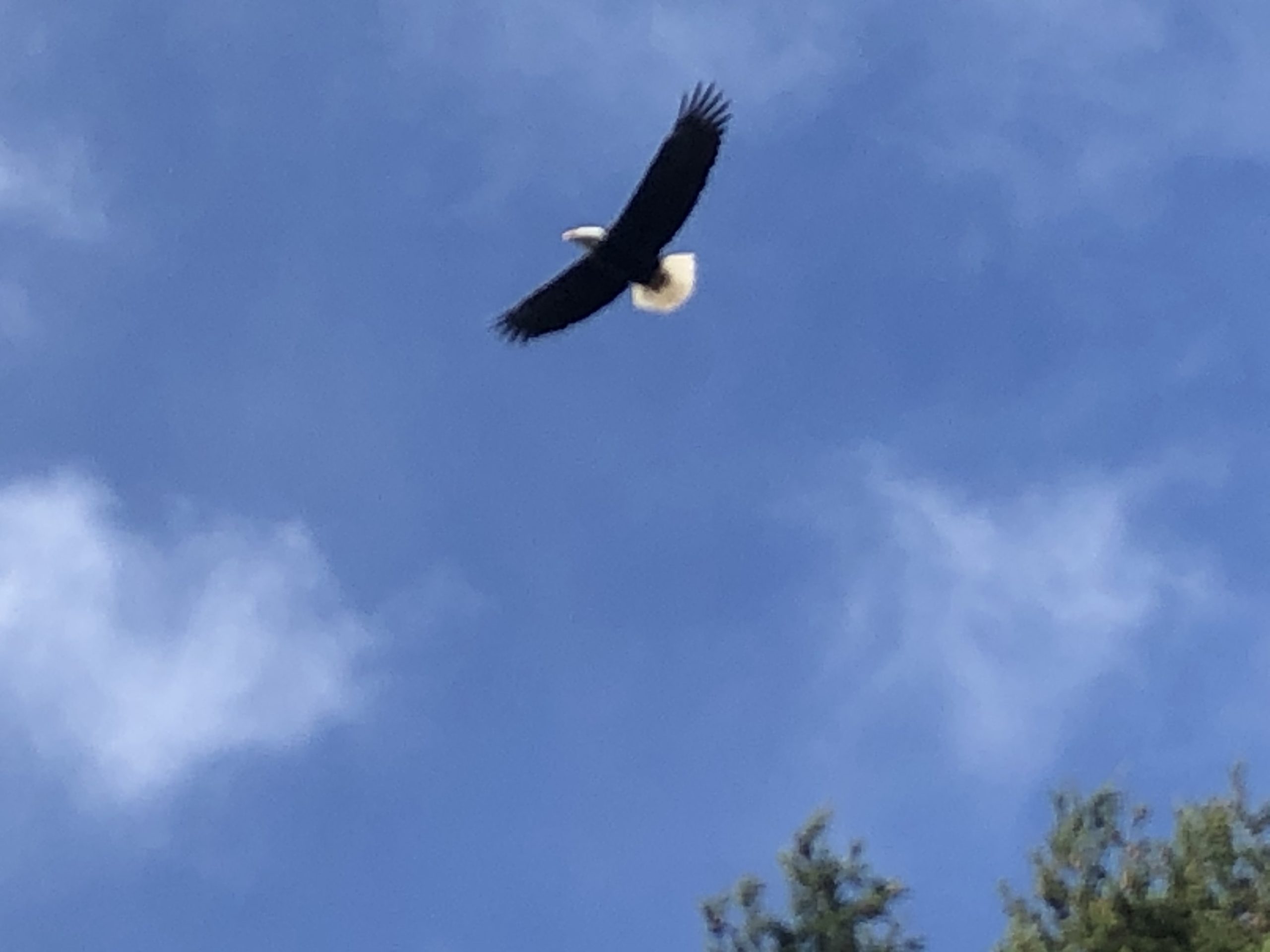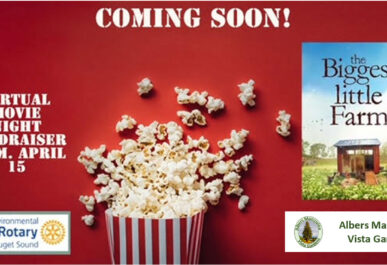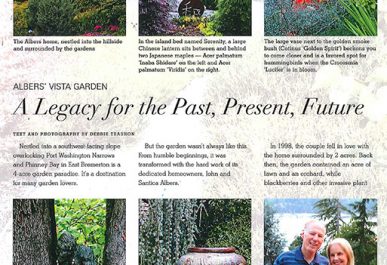
Gardening: a positive force in times of uncertainty and hardship
April 12, 2020
Bald Eagles Roosting in Hilltop Vista
March 5, 2021Madrona Woods is a nearly pristine native woodland of about 0.5 acres in the Northwest section of Vista Gardens. It is dominated by large Pacific madrone, Arbutus menziesii, and big leaf maple trees, Acer macrophyllum. It also contains numerous western hemlocks, Tsuga heterophylla, and several Douglas-fir, Pseudotsuga menziesii. The shrub layer is dominated by beaked hazelnut, Corylus cornuta, and evergreen huckleberry, Vaccinium ovatum. The principal groundcovers in this woodland are low Oregon grape, Berberis (Mahonia) nervosa, and salal, Gaultheria shallon.
The common name for Arbutus menziesii varies depending on where you live. We Washingtonians usually call it madrona after the Spanish name for the strawberry tree. Other Americans on the wet coast call it Pacific madrone or just madrone, while our Canadian friends to the north use the Latin name Arbutus.
The beautiful broadleaf Pacific madrone, with its showy orange to red peeling bark, is perhaps the most distinctive hardwood tree native to the west coast of North America, ranging from southwest British Columbia to southern California. It is well-adapted to the mild temperatures of western coastal areas of North America. It is both drought tolerant and drought dependent but has relatively low tolerance for shade, particularly in the northern regions of its range. While young seedlings do best in partial shade, as the trees get older, they have little tolerance for shade and do best in full sun. That is why several madrones in Madrona Woods are twisted or bent at an odd angle to maximize the amount of sunlight they receive. Madrones prefer well-draining, rocky, or gravelly, south, or west facing soils as their fine roots go deeply into the rocks to obtain water. Thus, madrones are excellent trees for stabilizing slopes and minimizing landslides. Madrone roots are associated with a network of mycorrhizal fungi, which facilitate nutrient and water transfer to madrone while the madrone provides the fungi with sugars through photosynthesis. The evergreen madrone sprouts new glossy green leaves in spring and two-year old leaves turn yellow or burnt orange and drop to the ground in summer. It produces large, drooping clusters of lovely, fragrant, creamy white, urn-shaped flowers in spring and bright red berries in fall, providing excellent food for birds and mammals. Pollinators, such as bees, butterflies, hoverflies and hummingbirds, feed on the flower nectar. The cavities found in both live and dead madrone trees provide excellent nesting sites for cavity-nesting birds.
The madrone is declining in some regions of Puget Sound, Including in Vista Gardens. The reasons for its decline are not completely clear, but multiple factors likely play a role. Sadly, a lot of large, venerable old trees in the Puget Sound region have been removed to make way for urban development. Madrone trees are particularly sensitive to variations in the environment as evidence by the large variation in the width of the madrone’s tree ring size. Fortunately, the madrones in Madrona Woods have not been subjected to soil compaction or other soil disturbance, but a change in soil drainage could be a plausible factor because of a new housing development on an adjacent hillside. Our very wet and mild winters and wet spring are not ideal for madrones, particularly in shady conditions. The trees are susceptible to numerous fungal diseases, including root disease, stem and branch cankers, branch dieback, leaf spots, and leaf blight. A variety of Insects then attack the weakest trees. The spindly, tall, and narrow madrones with thin shedding bark, characteristic of the trees now in Vista Gardens, appear to be more susceptible to canker disease. Cankers at the base of the tree reduces the likelihood that these trees will resprout once the top portion dies or is cut down.
Twenty years ago, the madrones in Vista Gardens were all alive (except for a very large old one), and for the most part, healthy. Now, cankers, leaf spot, leaf blight, and branch dieback, are all readily evident and six large madrones have died and others appear that they may succumb soon. When we first purchased this land, more than a hundred madrone seedlings were generated every year. These young seedlings were potted into biodegradable containers and made available for planting to the local community. Unfortunately, after a few years the number of seedlings began to decline, and they have continued to decline to the point that madrone regeneration has stagnated, and new madrone seedlings are no longer evident.
Over the years with growth and increase in the numbers of big leaf maples and beaked hazelnuts, any viable seedlings would be in shadier conditions and in the presence of excess leaf litter from the big leaf maple leaves. These conditions are likely to enhance more fungal diseases and exacerbate the loss of seedlings from damping-off and the browsing of insect and other invertebrate herbivores. The changing climate could also contribute to the decline of our madrones in the Puget Sound region as we are experiencing warmer and dryer summers combined with mild, very wet winters and wet springs which can contribute to susceptibility to more fungal diseases.
A warming climate is also altering the distribution and numbers of insects and wildlife that could negatively impact the health of madrones. Twenty years ago, there were native squirrels and chipmunks present, but now with a proliferation of the invasive eastern gray squirrel, we no longer see our native squirrel species. Also, the stripping of bark on the lower portions of trees is quite evident, most likely due to the activity of the eastern gray squirrel. Whether the eastern gray squirrels are doing damage to our beloved madrones remains to be seen, but I will be keeping a close eye on these invasive pests. In the past, fire contributed to the regeneration of madrone woodlands, but current fire suppression practices negate this potential regenerative strategy. Increased pollution that accompanies urbanization can also play a role in tree decline. However, I am thankful that we in Kitsap County are generally blessed with excellent air quality except when we experienced excessive smoke from the fires in California and Oregon. Thus, pollution is not likely to play a significant role in Madrone decline at Vista Gardens but could certainly be a factor in their decline in the more urban areas of Puget Sound.
My wife and I have decided to undertake the big challenge to restore Madrona Woods. The first step is to remove the large, dead madrones that pose a hazard to our visitors and then remove several of the large, big leaf maple trees. When possible, the lower portion of the trees will be left as a snag to be used by wildlife for shelter, food source, nesting, roosting, and perching. The large fallen trees will remain on the ground to provide habitat for decomposers and serve as nurseries for seedlings and other organisms. Next, excess underbrush will be removed, and the shrubs thinned out, particularly the beaked hazelnut, to allow more sunlight into the woodland. We plan to use some of the limbs from the trees and shrubs to make brush piles to serve as habitat for wildlife. Unwanted non-natives, especially the invasive English ivy and Himalayan blackberry will be removed. Woodchips will be added to the paths to minimize compaction of the clay soil. Seedling madrones will be planted in the more open spaces in the woodland, along with the selective addition of compatible plants with similar needs and mycorrhizal associations. Pictures of the various phases of the restoration will be taken and posted on the garden webpage.
The madrone, endemic to the Pacific coast, is an iconic species which has played an important role in our regional heritage. It has lived in Madrona Woods and other coastal regions for hundreds of years. To preserve Madrona Woods and all its ecosystem benefits we need to work harmoniously with nature and its surroundings to permit the conservation and sustainable management of madrones and their ecosystem. Protection and sustainable management of urban nature is everyone’s responsibility. Anyone who desires to help with the restoration of Madrona Woods or has questions or specific suggestions/comments please contact me at Info@albersvistagardes.org.




